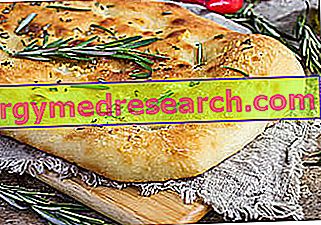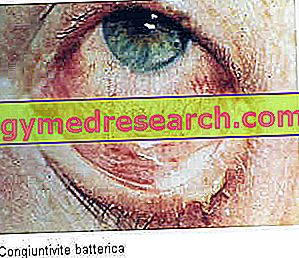Generality
Focaccia is the generic term used to indicate a food belonging to the bread and derivatives group. There are many types, which differ from one another in terms of ingredients, preparation methodology and final result; there are sweet focaccias and savory buns, the latter much more numerous and widespread than the former.

The basic ingredients of the focaccia are: wheat flour, natural yeast, water and a lipid source (oil or lard). To these can be added: other cereal flours, boiled flour of legumes or pulses, vegetables, fruits, meats, cheeses, fishery products and eggs. Almost all the focaccias need two leavening: one of the primary dough (often already preformed) and another of the seasoned dough.
The substantial difference with respect to bread consists in the greater lipid percentage of the focaccia. It is therefore a fairly caloric food, to be consumed as a single dish, possibly far from the main meals and better if in the presence of a good level of overall physical activity.
Nutritional aspects
The Genoese focaccia is a very energetic food, even if in the table below some values appear that do NOT accurately reflect the nutritional content of the product. This is because indirect nutritional translation does not take into account the dehydration that occurs during cooking, but only examines the chemical values of the raw ingredients.
The energy of the Genoese focaccia is provided mainly by carbohydrates, followed by lipids and finally by proteins. The carbohydrates in question are almost completely complex (starch), the peptides are of medium biological value, while the fatty acids appear in favor of the unsaturated (mainly monounsaturated).
Nutritional values | |||||||||||||||||||||||||||||||||||||||||||||||||||||||||||||||||||||||||||||||||||||||||||||||||||||||||||||||||||||||||||||||||||||||||||||||||
Composition for 100g of Genovese Focaccia | |||||||||||||||||||||||||||||||||||||||||||||||||||||||||||||||||||||||||||||||||||||||||||||||||||||||||||||||||||||||||||||||||||||||||||||||||
 | |||||||||||||||||||||||||||||||||||||||||||||||||||||||||||||||||||||||||||||||||||||||||||||||||||||||||||||||||||||||||||||||||||||||||||||||||
| |||||||||||||||||||||||||||||||||||||||||||||||||||||||||||||||||||||||||||||||||||||||||||||||||||||||||||||||||||||||||||||||||||||||||||||||||
In the Genoese focaccia, which contains oil and not lard, cholesterol is absent and the fibers are present in medium quantities.
The only abundant mineral salt is sodium which, on the other hand, is not a desirable nutritional element. In fact, if present in excess, sodium predisposes to the aggravation of arterial hypertension, besides being a risk factor for some digestive discomforts.
Also among the vitamins no nutritional contributions worth mentioning are noted, except for the discreet presence of tocopherols (vitamin E).
The Genoese focaccia is not a suitable food for the overweight person, type 2 diabetic and hypertriglyceridemic. As anticipated, it is to be avoided in case of arterial hypertension, but in normopeso subjects it does not present aggravating effects on hypercholesterolemia.
The Genoese focaccia contains gluten, which is why it should be excluded from the celiac diet.
The medium portion, if used as a snack, should range between 40 and 50g.
ATTENTION! The recipe used for the nutritional translation shown in the table is to be considered rather "light"; most of the Genoese focacce that can be found on the market have a quantity of oil at least 50% higher.
Synonyms and Recipes
As anticipated, the focaccia can take several different names; some of these are: fogazza, fugassa, pizza, savory pie, white pizza, pinzone, pinza, schiacciata, schiacciata, schiaprina, crescia, crescenta etc.
The most famous focaccia is the Genoese focaccia; the ingredients are: 00-type wheat flour, water, malt, brewer's yeast, water, salt and extra virgin olive oil. Also called fugassa, it is the result of one of the simplest recipes ever. It is golden yellow in color, generally rectangular in shape (less frequently “wheeled”) and about 2cm thick. It is very fatty and quite tasty. Sometimes it can be enriched with thinly sliced onion, olives, salami, aromatic herbs and potatoes.
In Recco a slightly different focaccia is made, made with the addition of cheese; although the latter ingredient can also be added to the Genoese focaccia, it characterizes Recco's " fugassa co formaggio ". Another rather similar product from areas not too far away is the focaccia novese.
Changing the area completely, we mention the Bari focaccia . This, typical of various municipalities in the Puglia region, differs from the previous ones in terms of the presence of durum wheat flour and the richness of the ingredients used in it: tomatoes, black olives and spices (all together). Obviously, they also produce white and simple. The Apulian focaccia was born because of the need to exploit the heat of the wood oven initially too high; in fact, trying to cook the bread immediately, there would be the risk of burning it outside, leaving it raw inside. Let us not forget that the typical bread of these areas is the altamura, a very large product that therefore requires a lot of attention during cooking.
In Tuscany a typology of focaccia called schiacciata or schiaccia or schiaccina or ciaccia is widespread; also known as Florentine focaccia, it is quite similar to the Genoese focaccia but generally it is about 1cm thicker. It is seasoned with oil and salt, and is used to accompany cold cuts and cheeses.
Strazzata is a typical focaccia from the Basilicata region. In addition to the ingredients of the Genoese one, it also contains a part of bran, ground black pepper and sometimes diced lard. It is called torn, because it is broken with the hands. The form is characteristic; it is round with a hole in the center and is served stuffed with provolone and ham.
In Sicily there is a type of focaccia called vastedda . It is of considerable size and has a circular shape; cooking can take place in the oven or in a pan (thick) even if, in the latter case, you get a completely different product.
Then we come to the focaccias that are very different from the Genoese. The Umbrian-Marche focaccia, called crescia, is much more like a piadina. It has a flattened shape but, unlike the latter, it also contains eggs. The Umbrian-Marche focaccia is less prone to individual consumption and lends itself to accompanying cold cuts, cheeses and cooked grass.
Then there is a totally different kind of crescia marchigiana. Contrary to the previous one it is tall, well leavened and of an intense yellow color; is the crescia al formaggio, a typical Easter food.
Let's not forget the sweet focaccias, of which they are typical examples: the focaccia of Susa (Piedmontese), the Venetian focaccia, the Sicilian cuddura etc. These are foods that contain lower concentrations of fat (frequently made up of butter) and greater quantities of sugar or other sweet ingredients (such as raisins, honey, etc.); almost always involve the use of eggs.
Integral Rustic Focaccia
The video shows how to prepare in a few minutes a light and crunchy focaccia, with a rustic taste, with whole wheat flour, a little oil, cherry tomatoes, olives and anchovies, ideal to serve as a main dish.
Rustic focaccia with whole wheat flour
X Problems with video playback? Reload from YouTube Go to Video Page Go to Video Recipes Section Watch the video on youtube



